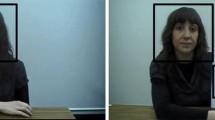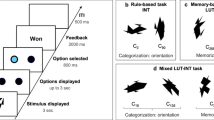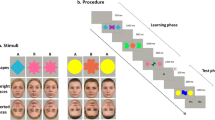Abstract
We examined how performance on an associative learning task changes in a sample of undergraduate students as a function of their autism-spectrum quotient (AQ) score. The participants, without any prior knowledge of the Japanese language, learned to associate hiragana characters with button responses. In the novel condition, 50 participants learned visual-motor associations without any prior exposure to the stimuli’s visual attributes. In the familiar condition, a different set of 50 participants completed a session in which they first became familiar with the stimuli’s visual appearance prior to completing the visual-motor association learning task. Participants with higher AQ scores had a clear advantage in the novel condition; the amount of training required reaching learning criterion correlated negatively with AQ. In contrast, participants with lower AQ scores had a clear advantage in the familiar condition; the amount of training required to reach learning criterion correlated positively with AQ. An examination of how each of the AQ subscales correlated with these learning patterns revealed that abilities in visual discrimination—which is known to depend on the visual ventral-stream system—may have afforded an advantage in the novel condition for the participants with the higher AQ scores, whereas abilities in attention switching—which are known to require mechanisms in the prefrontal cortex—may have afforded an advantage in the familiar condition for the participants with the lower AQ scores.





Similar content being viewed by others
References
Bailey A, Le Couteur A, Gottesman I, Bolton P, Simonoff E, Yuzda E, Rutter M (1995) Autism as a strongly genetic disorder: evidence from a British twin study. Psychol Med 25(1):63–77
Baron-Cohen S, Hammer J (1997) Parents of children with Asperger syndrome: What is the cognitive phenotype? J Cognitive Neurosci 9(4):518–554
Baron-Cohen S, Wheelwright S, Skinner R, Martin J, Clubley E (2001) The autism-spectrum quotient (AQ): evidence from Asperger syndrome/high-functioning autism, males and females, scientists and mathematicians. J Autism Dev Disord 31(1):5–17
Bayliss AP, Tipper SP (2005) Gaze and arrow cueing of attention reveals individual differences along the autism spectrum as a function of target context. Brit J Psychol 96(1):95–114
Boettiger CA, D’Esposito M (2005) Frontal networks for learning and executing arbitrary stimulus-response associations. J Neurosci 25(10):2723–2732
Bölte S, Poustka F (2006) The broader cognitive phenotype of autism in parents: How specific is the tendency for local processing and executive dysfunction? J Child Psychol Psyc 47(6):639–645
Bölte S, Holtmann M, Poustka F, Scheurich A, Schmidt L (2007) Gestalt perception and local-global processing in high-functioning autism. J Autism Dev Disord 37(8):1493–1504
Buchsbaum BR, Greer S, Chang WL, Berman KF (2005) Meta-analysis of neuroimaging studies of the Wisconsin card-sorting task and component processes. Hum Brain Mapp 25(1):35–45
Chouinard PA, Goodale MA (2009) FMRI adaptation during performance of learned arbitrary visuomotor conditional associations. Neuroimage 48(4):696–706
Chouinard PA, Noulty WA, Sperandio I, Landry O (2013) Global processing during the Muller-Lyer illusion is distinctively affected by the degree of autistic traits in the typical population. Exp Brain Res 230:219–231
Christ SE, Kanne SM, Reiersen AM (2010) Executive function in individuals with subthreshold autism traits. Neuropsychology 24(5):590–598
Cohen BH (1996) Explaining psychological statistics, 1st edn. Brooks/Cole Publishing Company, Pacific Grove
Ebbinghaus H (1913) Memory: a contribution to experimental psychology. Teachers college. Columbia University, Columbia (Ruger HA, & Bussenius CE, Trans)
Fisher RA (1915) Frequency distribution of the values of the correlation coefficient in samples of an indefinitely large population. Biometrika 10(4):507–521
Frith U (2003) Autism: explaining the enigma, 2nd edn. Blackwell Publishing, Oxford
Gaugler T, Klei L, Sanders SJ, Bodea CA, Goldberg AP, Lee AB, Buxbaum JD et al (2014) Most genetic risk for autism resides with common variation. Nat Genet 46:881–885
Gilotty L, Kenworthy L, Sirian L, Black DO, Wagner AE (2002) Adaptive skills and executive function in autism spectrum disorders. Child Neuropsychol 8(4):241–248
Grol MJ, de Lange FP, Verstraten FAJ, Passingham RE, Toni I (2006) Cerebral changes during performance of overlearned arbitrary visuomotor associations. J Neuroscience 26(1):117–125
Happé F (1999) Autism: Cognitive deficit or cognitive style? Trends Cogn Sci 3(6):216–222
Happé F, Frith U (2006) The weak coherence account: detail-focused cognitive style in autism spectrum disorders. J Autism Dev Disorder 36(1):5–25
Happé F, Briskman J, Frith U (2001) Exploring the cognitive phenotype of autism: weak “central coherence” in parents and siblings of children with autism: i experimental tests. J Child Psychol Psyc 42(3):299–307
Harlow JM (1868) Recovery after severe injury to the head. Mass Med Soc 3–20
Hill EL (2004) Evaluating the theory of executive dysfunction in autism. Dev Rev 24(2):189–233
Hudson M, Nijboer TC, Jellema T (2012) Implicit social learning in relation to autistic-like traits. J Autism Dev Disord 42(12):2534–2545
Hughes C, Leboyer M, Bouvard M (1997) Executive dysfunction in parents of children with autism. Psychol Med 27(1):209–220
Hughes C, Plumet MH, Leboyer M (1999) Towards a cognitive phenotype for autism: increased prevalence of executive dysfunction and superior spatial span amongst siblings of children with autism. J Child Psychol Psyc 40(5):705–718
Hurst RM, Nelson-Gray RO, Mitchell JT, Kwapil TR (2007) The relationship of Asperger’s characteristics and schizotypal personality traits in a non-clinical adult sample. J Autism Dev Disord 37(9):1711–1720
Jolliffe T, Baron-Cohen S (1997) Are people with autism and Asperger syndrome faster than normal on the Embedded Figures Test? J Child Psychol Psyc 38(5):527–534
Kanner L (1943) Autistic disturbances of affective contact. Nerv Child 2(1943):217–250
Kim JA, Szatmari P, Bryson SE, Streiner DL, Wilson FJ (2000) The prevalence of anxiety and mood problems among children with autism and Asperger syndrome. Autism 4(2):117–132
Luria AR (1966) The higher cortical functions in man. Basic Books, New York
McEvoy RE, Rogers SJ, Pennington BF (1993) Executive function and social communication deficits in young autistic children. J Child Psychol Psyc 34(4):563–578
Müller RA, Kleinhans N, Kemmotsu N, Pierce K, Courchesne E (2003) Abnormal variability and distribution of functional maps in autism: an fMRI study of visuomotor learning. Am J Psychiat 160(10):1847–1862
Müller RA, Cauich C, Rubio MA, Mizuno A, Courchesne E (2004) Abnormal activity patterns in premotor cortex during sequence learning in autistic patients. Biol Psychiat 56(5):323–332
Oldfield RC (1971) The assessment and analysis of handedness: the Edinburgh inventory. Neuropsychologia 9(1):97–113
Palermo MT, Pasqualetti P, Barbati G, Intelligente F, Rossini PM (2006) Recognition of schematic facial displays of emotion in parents of children with autism. Autism 10(4):353–364
Pellicano E (2007) Links between theory of mind and executive function in young children with autism: clues to developmental primacy. Dev Psychol 43(4):974–990
Pellicano E (2010) Individual differences in executive function and central coherence predict developmental changes in theory of mind in autism. Dev Psychol 46(2):530–544
Petrides M (1982) Motor conditional associative-learning after selective prefrontal lesions in the monkey. Behav Brain Res 5(4):407–413
Petrides M (1985) Deficits in non-spatial conditional associative learning after periarcuate lesions in the monkey. Behav Brain Res 16(2–3):95–101
Petrides M, Alivisatos B, Evans AC, Meyer E (1993) Dissociation of human mid-dorsolateral from posterior dorsolateral frontal cortex in memory processing. Proc Natl Acad Sci USA 90(3):873–877
Piaget J (1954) The construction of reality in the child. Basic Books, New York
Piven J (2001) The broad autism phenotype: a complementary strategy for molecular genetic studies of autism. Am J Med Genet 105(1):34–35
Poljac E, Poljac E, Yeung N (2012) Cognitive control of intentions for voluntary actions in individuals with a high level of autistic traits. J Autism Dev Disord 42(12):2523–2533
Reed P, Lowe C, Everett R (2011) Perceptual learning and perceptual search are altered in male university students with higher Autism Quotient scores. Pers Indiv Differ 51(6):732–736
Richmond LL, Thorpe M, Berryhill ME, Klugman J, Olson IR (2013) Individual differences in autistic trait load in the general population predict visual working memory performance. Q J Exp Psychol (Hove) 66(6):1182–1195
Russell J (1995) Autism as an executive disorder. Oxford University Press, Oxford
Russer TF, Arin D, Dowd M, Putnam S, Winkolsky B, Rosen-Sheidley B, Folstein S et al (2007) Communicative competence in parents of children with autism and parents of children with specific language impairment. J Autism Dev Disord 37(7):1323–1336
Shah A, Frith U (1983) An islet of ability in autistic children: a research note. J Child Psychol Psyc 24(4):613–620
Stewart ME, Watson J, Allcock AJ, Yaqoob T (2009) Autistic traits predict performance on the block design. Autism 13(2):133–142
Sucksmith E, Roth I, Hoekstra RA (2011) Autistic traits below the clinical threshold: re-examining the broader autism phenotype in the 21st century. Neuropsychol Rev 21(4):360–389
Sullivan EV, Mathalon DH, Zipursky RB, Kersteen-Tucker Z, Knight RT, Pfefferbaum A (1993) Factors of the Wisconsin Card Sorting Test as measures of frontal-lobe function in schizophrenia and in chronic alcoholism. Psychiatry Res 46(2):175–199
Toni I, Passingham RE (1999) Prefrontal-basal ganglia pathways are involved in the learning of arbitrary visuomotor associations: a PET study. Exp Brain Res 127(1):19–32
Toni I, Rowe J, Stephan KE, Passingham RE (2002) Changes of cortico-striatal effective connectivity during visuomotor learning. Cereb Cortex 12(10):1040–1047
Whitehouse AJ, Barry JG, Bishop DV (2007) The broader language phenotype of autism: a comparison with specific language impairment. J Child Psychol Psyc 48(8):822–830
Yelle LE (1979) The learning curve: historical review and comprehensive survey. Decision Sci 10(2):302–328
Zalla T, Sav AM, Leboyer M (2009) Stimulus-reward association and reversal learning in individuals with asperger syndrome. Res Autism Spect Dis 3(4):913–923
Acknowledgments
The authors would like to thank Mr. Michael Conley, Ms. Kaitlyn Doucette, Mr. Ari Franklin, and Ms. Elena Lesaru for their assistance in data collection. This work was supported by a Fellowship award to Philippe A. Chouinard from the Ontario Mental Health Foundation.
Author information
Authors and Affiliations
Corresponding author
Additional information
Karisa B. Parkington and Rebecca J. Clements have contributed equally to this work.
Rights and permissions
About this article
Cite this article
Parkington, K.B., Clements, R.J., Landry, O. et al. Visual-motor association learning in undergraduate students as a function of the autism-spectrum quotient. Exp Brain Res 233, 2883–2895 (2015). https://doi.org/10.1007/s00221-015-4358-x
Received:
Accepted:
Published:
Issue Date:
DOI: https://doi.org/10.1007/s00221-015-4358-x




